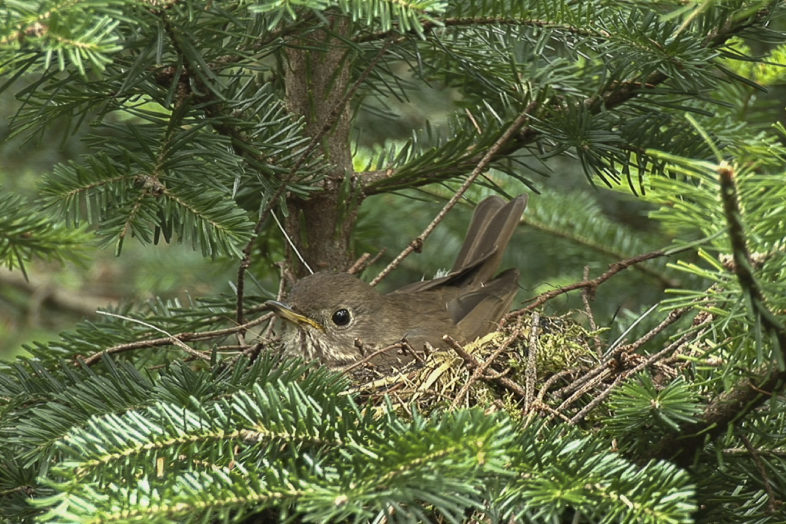
Bicknell’s Thrush (Catharus bicknelli) incubating a nest on Stratton, Vermont. Photo by K.P. McFarland
The US Fish and Wildlife Service (USFWS) has chosen not to list Bicknell’s Thrush as federally Threatened or Endangered, thus ending a story that began seven years earlier. In the boilerplate language that characterizes official decisions of this kind: “After review of the best available scientific and commercial information, we find that listing the Bicknell’s Thrush is not warranted”. The official announcement will be published soon in the Federal Register; a preview is available now.
The long and winding path to this decision included two lawsuits – USFWS, which administers the Endangered Species Act, had failed to meet the statutory timeline for completing its analyses – and two court-ordered settlements. In the end, it was a settlement with the Center for Biological Diversity, the group that originally petitioned to have Bicknell’s Thrush listed under the Endangered Species Act (ESA), that led to today’s decision.
The decision not to list Bicknell’s Thrush as Threatened or Endangered does not change the biological reality that the species remains vulnerable to a host of threats (worth noting is that Bicknell’s Thrush is already listed as Threatened in Canada). Indeed, the analysis prepared by USFWS reached largely the same conclusion arrived at by the International Bicknell’s Thrush Conservation Group: habitat loss due to climate change and deforestation represent grave problems for the species’ long-term viability.
In fact, today’s decision is more about USFWS policy towards analyzing extinction risk than it is about extinction risk itself. Notably, USFWS used a 30-year timeline as the framework for its analysis. This timeline – like any – is arbitrary, and reflects the current interpretation of the ESA’s vague language, which requires that analyses of extinction risk address the “foreseeable future”. What constitutes the “foreseeable future” is of course debatable, especially when considering climate change or deforestation. In any case, over the 30-year timeline considered in its analysis, USFWS found no compelling evidence that habitat loss would be so severe as to bring Bicknell’s Thrush to the point of extinction. Had the “foreseeable future” included the next 50 or 100 years, this conclusion might very well have been different.
The decision not to list Bicknell’s Thrush must not be interpreted as a sign that our job as conservationists and scientists is done. On the contrary, it reinforces the importance of the collaborative, science-based conservation work of VCE and all of our partners in the International Bicknell’s Thrush Conservation Group. We need to prevent continued increases in the atmospheric concentration of greenhouse gases, and we must develop smart responses to the changes that we’ve baked into the system with the past 100 years of carbon pollution. We must redouble efforts to find sustainable solutions to halt deforestation in Haiti and the Dominican Republic. We still need to find ways to ensure that Bicknell’s Thrush can co-exist and even thrive in forests managed for timber in the US and Canada. We must better understand the vulnerability of Bicknell’s Thrush on both its breeding and wintering grounds, so we can prioritize conservation projects. And, we need to do all of this – and more – not because the law requires it, but because it is our fundamental responsibility.
